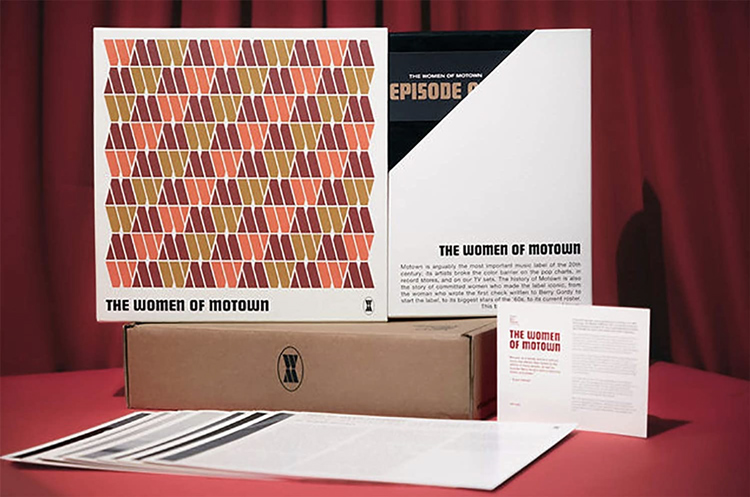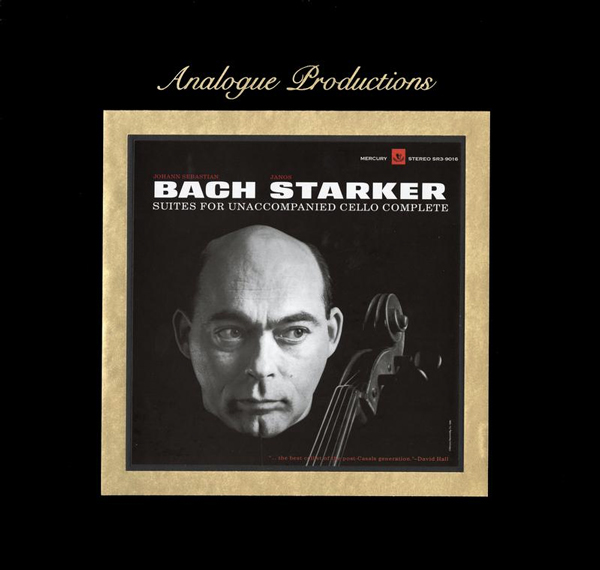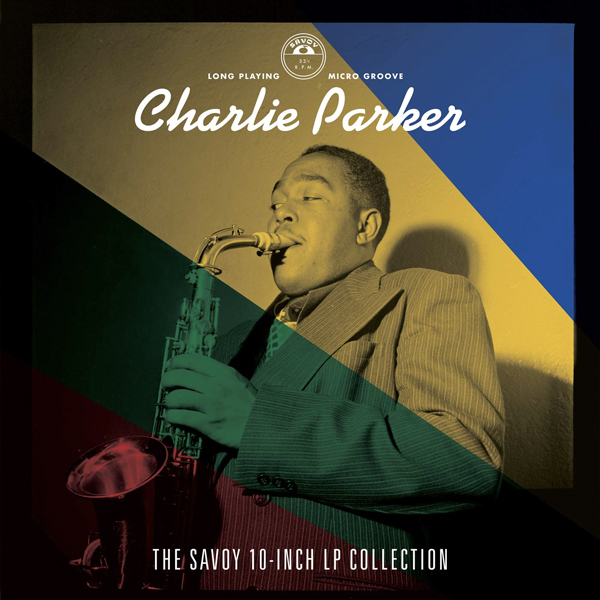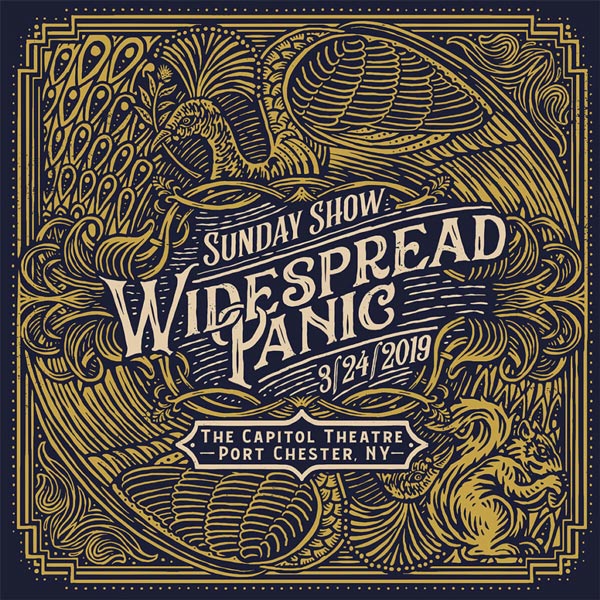
Vinyl Me, Please has a branch of their operations dedicated to anthologies. So far, they’ve all been presented as box sets. I whiffed on the Blue Note set, and I have a hard time imagining what anyone would do with those recordings to top what music Matters has already done. I’ll also be passing on the forthcoming Dead box (although it looks compelling, I admit), but will be keeping an eye out for details related to their Herbie Hancock set. I did circle back for their Women of Motown collection, which is still available online despite it being out of print and unavailable at the VMP site. I’m not sure I’ve ever had more fun with a set of records.
VMP designed this collection as an experience beyond what one might typically expect to have when engaging with a vinyl box set. The eight full-length albums were divided into chronological “episodes” such that episode one includes Bye Bye Baby by Mary Wells, Heat Wave by Martha and the Vandellas, and Where Did Our Love Go by the Supremes. The second consists of Irresistible by Tammi Terrell, and an eponymous album by Stevie Wonder’s protegé (and ex-wife) Syreeta. Episode three features Totally Tata by Tata Vega (who was profiled in the 40 Feet From Stardom doc), It Must Be Magic by Teena Marie, and Worldwide Underground by Erykah Badu (the set’s lone two-disc offering).
Get this: for early subscribers, the second and third episodes were shipped in blackout wrapping so that the contents were obscured inside the box. That’s because podcasts (accessible to purchasers via an included exclusive code) were made for each “episode.” These were released every two weeks so that listeners with more patience than I have could wait to open the hidden discs in conjunction with exploring the linked articles/journalism and listening to the podcasts, which included historical, biographical, and personal information provided by the hosts, one of whom literally wrote the book on the Women of Motown. This undoubtedly amplified the experience for listeners and was likely ten tons of fun. And I love a deep dive as much as the next guy, but the real fun is in the listening.
Because all of these records were very well-pressed by QRP in Kansas. I don’t have both feet firmly on their bandwagon. They’re like an athlete with all the natural gifts needed to dominate, but who struggles with their motivation and consistency. QRP did a really great job with this set though. Full stop. The records were AAA cut from the original master tapes by Ryan K. Smith except for the Badu record, which was recorded digitally in the first place.
Interestingly, the Vandellas, Supremes, and Tammi Terrell records are really the only ones in the set that demonstrate what most of us think of as “The Motown Sound.” The Wells record is a Blues album. It’s triumphantly rough with some occasional vocal distortion that is likely in the original masters. The Syreeta record is noted on the forums for having some inner groove distortion on the first side, but I eliminated this by adjusting my tone arm’s weight. Which is exciting because Syreeta easily counts as my favorite discovery in the set. It’s essentially an early-70s Stevie Wonder record with Syreeta singing over his grooves. His brand of Synthesizer Space Funk exists outside of time, and it would have been impossible for me to tell when this record was released just based on listening.
The mid- to latter-era discs are all a blast too. Vega’s singing is especially joyful, and Teena Marie’s bubble gum pop crossed with Rick James sleaze results in a surprisingly strong listen. This set tells such a gripping story that any ending would almost seem lacking, but the Badu album really puts the perfect cherry on top. It somehow exemplifies everything that came before it without being in any way derivative. It is the opposite of a “canned” performance, and it reveals more of Badu’s character than would have been allowed by earlier artists.
In summary: If you can’t have fun with this set, you should head to the ER immediately. You can engage with the music emotionally due to the stellar presentation and the sheer majesty of the original recordings. Or you could take a different tack and enjoy a more cerebral experience while listening to or reading the bonus content and liners. I do both at once, and I’ll do it all over again and again. I got #96. You should get one of the other 999 copies out there. You’ll love it.

When I was in graduate school, I set out to find some Classical music that could calm me down during eras of high stress. I didn’t realize at the time that entire years would be eaten up with high stress and that I’d be restricted to my home for all but the most essential outings for months at a time. And that I’d be too damned anxious to socialize once I was allowed to. So it’s a good thing I figured this Classical music business out. I learned that much of it actually takes me in the wrong direction. Too many swells and crescendos make Jack a jumpy boy. But I also learned that Bach often puts me right where I want to be. So I grabbed a copy of Bach: Suites for Unaccompanied Cello Complete as performed by Janos Starker and reissued by Speakers Corner. And then I put a tiny scratch at the very beginning that causes eight little “ticks.” This was devastating to a compulsive weirdo like me, so I used that as an excuse to plunk down for Analogue Productions’s more recent reissue of the same title. So… shootout?
Secrets Sponsor
The Speakers Corner take on this set has been highly regarded in the audiophile community since its birth in 2004. Many folks consider it to be amongst the finest sounding sets in their collections. AP seemed to upend that a bit. Most listeners prefer it, and I am amongst them. The SC take is a little heavy on the bass notes with a lack of air in the top end. Some people complain of a continuous rumble, which sort of sums up audiophiles in general, right? “It’s the finest recording in the history of music!” “No, there’s a low rumble throughout all six sides! Are you deaf? I bet your system sucks.” “My system is made from the spirits of dead saints, and there’s no rumble, and you probably made that up because you hate Bach…” I never heard a rumble, and I’d have been happy to have the SC version as mine forever were it not for that mishap. But I’m glad I got the AP version because I think it is more detailed, alive, and balanced. Both versions are so clear that you can hear Starker bowing his instrument at times, which almost sounds like a pressing defect. This is the kind of music that makes you feel smart for listening to it. It is so simultaneously joyful, soothing, and intense. I dare say that it is one of the finest musical programs I’ve been fortunate enough to experience in my home.
Now, hear this…
AP describes their QRP-pressed version as “definitive” in their hype video. It probably is. But there’s at least one glaring pressing defect that causes static in the left channel at the conclusion of the first movement on side two. People are discussing it in the forums, and none other than Michael Fremer himself alludes to it having been fixed in the repress that he was sent. And AP uses parts of his review in their marketing materials for their set. But they denied having any knowledge of the problem when I emailed them about my defective copy. They just sent me another defective replacement. They refused to send me a “fixed” copy from the repress, and said something along the lines of “we hope you enjoy the other eleven sides.” (To be clear: I am never given “reviewer’s copies” of the records we explore at this site. I buy what everyone else does.) Some have complained about persistent issues related to surface noise throughout their sets, but that has not been my experience. My records are mostly silent when they’re supposed to be.
This is great because there is much to explore throughout these six 200-gram records cut at 45 rpm. We have one suite per record on the AP take as opposed to one suite per side, as presented by SC. No movements span sides on the AP version, so there are no annoying fade-outs during individual pieces or anything as base as that. The liners include a program that one can follow along with to learn more about the various movements, the qualities that they share with each other, and the features that separate them. This information could presumably be applied to similar Classical works as well. And it may also help the listener to develop their vocabulary for discussing works of this type, but much of it is over my head. I’d likely feel somewhat accomplished if I ever came to a place where I felt comfortable discussing the intricacies of Bach’s Preludes, but I probably won’t ever get there. I don’t know how much time I have left, and there is much work to be done. But I might be able to tell the difference between a Sarabande and a Gigue by listening, and that would be worth it to me.
If this type of thing is of any interest to you at all, I’d say you need to get your hands on one of the AP boxes before they’re gone. Do your best to be sure you’re getting a repress and hope that defect doesn’t make it into your box. The SC set has expanded liners printed on cooler paper, but AP wins for sonics. The clarity is shocking. It’s like sheltering in place with Janos Starker in your living room.

I first became aware of Charlie Parker as a freshman in high school while trying to pretend like I understood Kerouac. He loved Parker, so I did too. Or I tried to. I couldn’t ever quite get there then, but I certainly have by now. We’ll cut right to the chase and announce that I am pretty stoked to have Parker’s The Savoy 10-Inch LP Collection on my shelf. We are not betting at the high stakes table here. We are not in the audiophile arena. We’re in the business of having fun for now. And the Savoy set certainly facilitates that. Trust me on this one.
I bought a Parker comp on a truckstop cassette when I was about 15 and then went about the business of torturing all of my friends who could drive by blaring it in their cars every chance I got. Can you imagine? I got similar results by blasting Tom Waits CDs during parties of the same era. My efforts were not appreciated. Anyway, I couldn’t handle the speed of Parker’s style. Reminds me of a time I got on a friend’s bicycle in college after having had a couple at the bar downtown. I’d not been on a fancy bike before, and the damn thing just about took off without me. I gave the bike back immediately, but I kept working on that tape. I knew it contained the magic.
If you fast forward a couple of decades, you’ll find the author much more comfortable in the Jazz World, having familiarized himself with a host of players in a variety of styles. Circling back to Bird’s work seemed much less intimidating, and the speed seemed manageable. Now, I can appreciate Parker’s playing, innovation, and influence in a much more honest and genuine way. The bike feels safer.
The records are reproductions of the originals released in the early 50s that compiled Bird’s recordings from the mid-40s. The set is a compilation of compilations. The individual songs were recorded between 1944 and 1948. One might detect growth in the players’ performances over that time, but you’ll have to work for it. The works are not presented in chronological order, they are presented as they were released. The first record includes recordings made in 1944, 1945, and 1947, for example. The second from ’45 and ’47 only. So it’s a bit difficult to detect a linear growth pattern as far as the players are concerned. It’s not hard to have fun listening to this set though. That part is beyond obvious.
The liners provide a wealth of historical info that really sheds light on how these records were received at the time. There was a lengthy musicians’ union strike that ended just before these recordings being made. Thus, Parker and his bandmates had a couple of years to develop this sound in NYC clubs so that when the recording embargo was lifted, this new style burst forth in the studio fully formed. Until then, it had been all Armstrong and Big Band Swing. This stuff must have sounded like it was from outer space. Or like Hip-Hop sounded to my mom when I started wearing neon fat laces in my shoes.
It’s been difficult to find info on the sources used for this set, but they were likely digital. I’m not sure how many Parker recordings would even qualify for an audiophile treatment. Seems like the info would have to be pulled from old shellac, lacquers, acetates, and/or 78s. The presentation lacks depth and is often a bit distant, but nonetheless fiery. And essential. Players include Miles, Dizzy, Max Roach, and Bud Powell. It’s like a history lesson in a vinyl box. If we’re lucky, this history will repeat itself. Don’t let the speed scare you.

Widespread Panic had a box set scheduled for release on Record Store Day 2020, but that event got scuttled. Many artists withheld their RSD releases to unveil during some monthly events that are supposed to start in August and last through October. Not sure if we’re going to get to participate in San Francisco as my preferred local retailer still isn’t even open for curbside pickup. So in some ways, it’s nice that Panic went ahead and made their set available. I was especially excited because it allows me to maintain my complete Panic collection without having to get out of bed at 5am to stand in line. And because I wanted to hear what the “new” lineup sounds like now that they’ve had time to let their flavors meld. Sunday Show answers that. Resoundingly.
This one was recorded at the Capitol Theatre in Port Chester on March 24, 2019. The material spans the bulk of the band’s history but is notably light on original studio songs involving the band’s newest members, Jimmy Herring (lead guitar) and Duane Trucks (drums). The transition to having Trucks on drums was a surprisingly smooth one, and he seems to have been a more immediate fit than Herring was. This makes sense for a guitar-based band whose performances involve nightly improvisations. Herring is a versatile electric guitarist, probably amongst the most technically accomplished available. His playing veers into shredding territory at times, and he uses a fair amount of effects. Sometimes, he doesn’t sound like an entirely integrated member of the band to me. Sometimes he sounds like an iron-on patch as opposed to having been woven into the fabric. This might be why the listen involves less nostalgia than I might have expected. It’s a different sound than the one I’m accustomed to. And it comes with its own rewards and trade-offs for us old-timers – as might reasonably be expected. Fans who have been with the band for a while will undoubtedly have opinions on which songs or types of songs translate best for the current lineup.
Secrets Sponsor
The sonics for the set are pretty sweet. But only as sweet as the band’s rudeness allows. I say that lovingly. I was always confused about how the hippies connected with Panic as the band has a heavier hand than most of its contemporaries. It’s a darker sound, which comes through on this set. The sound is curvier than sharp but rarely light. Herring’s tone boasts a fair amount of bite on its own. And Kindercore has gifted us a set with which to explore all of those details in brilliant relief. All nine sides are damn near flawless. The tenth involves an etching. Panic has gone all-in on this. I’d prefer that the songs be spread out over all ten available sides so that the grooves could breathe more easily, but the excessive length of many of the band’s songs might have made formatting difficult. The songs on Sunday Show are presented in the order they were performed, so some of the “segues” span sides. It ain’t a perfect marriage, but it’s far from abusive. I don’t feel like I’m getting cheated if a jam fades out to end one side, then back in to start another. This ain’t Bach.
I think the performance, overall, is pretty superb. More engaging and “tight” than the most recent performances I’ve seen in person. “Disco” sounds like a Rock ’n Roll torpedo heading straight for the heart of the sun. Generally, the crunchier songs are a safe bet. But individual mileage will vary. Sunday Show would be a fine point of entry for newbies. I mean that as a high compliment. This one’s a keeper.

Alrighty. That just about does it for our box set blowout in August. Almost. Our last one barely counts as a vinyl box set by traditional standards. But when you add the hardbound book and the five broadside prints of poems to the two records, it almost requires a box to contain the set so…
We’re talking here about Language Lessons. It was produced under multiple umbrellas beneath the larger tent of Jack White’s Third Man Conglomerate. This one heralded the advent of the book publishing arm of White’s empire, Third Man Books. As such, it includes a hardcover book of poetry, fiction, and non-fiction. For me, it’s the highlight of the set because it includes unpublished poems by Frank Stanford as well as work by Third Man alums Stanford Starkweather (who also reads on the record) and Janaka Stucky. I’ve seen both of those cats read live, and they are not up to the same old crap. Stucky is one of the more intense performers I’ve seen in any setting. Starkweather will make you laugh until you cry, then cry about what you just laughed at.
The broadsides are fun too. The hype materials refer to them as “frameable,” which I suppose they are. They’re printed on 12×12 heavy stock paper. Those fit in frames. Of the five included, the C.D. Wright broadside is the easiest on the eyes. It includes a swampy little nature scene along with his poem. I made an effort a few years ago to purge my living space of the artwork I had involving words. Those were banished to the walk-in closet so that the living room felt quieter. Full disclosure: these poems probably won’t even make it into the walk-in closet. They’ll likely stay in the box. If I keep the box.
And I might not. I believe that it is poorly designed. The records and the book sit tightly within it, and there are no notches cut into the container for ease of access to the contents within. Everything sits flush. This means you have to either just dump everything out en masse and hope for the best, or you have to pry the box open in unintended ways so that the box’s integrity will suffer over time. It’s like that guy on the subway who sits with his backpack and his lunchbox on the seats next to him. Takes up too much space with no regard for the population issues affecting our planet and my record shelf.
The records pre-date the arrival of Third Man Pressing and were done at United in Nashville. Despite this, they are almost well-made. The second one is noisy. The records are a kitchen sink affair involving “jazz, psychedelic-punk, poetry, blues, and pop,” according to the marketers. Paul “Wine” Jones contributed an unreleased recording to cover the blues bit, so that’s exciting. Someone named Jem Cohen has a song on here called “Happiness” that I like a lot. The individual recordings were made to various standards of quality in a variety of settings. The content is the thing. Audiophiles need not apply.
Overall, this is a fun, if not essential, set. Not sure I’ll get a ton of play out of the records, but I’m enjoying the book. You can come back to it over time, and find something new that might not have compelled you on the first pass. You can grow with it. The set is still available, and at a discount. You might like it.


